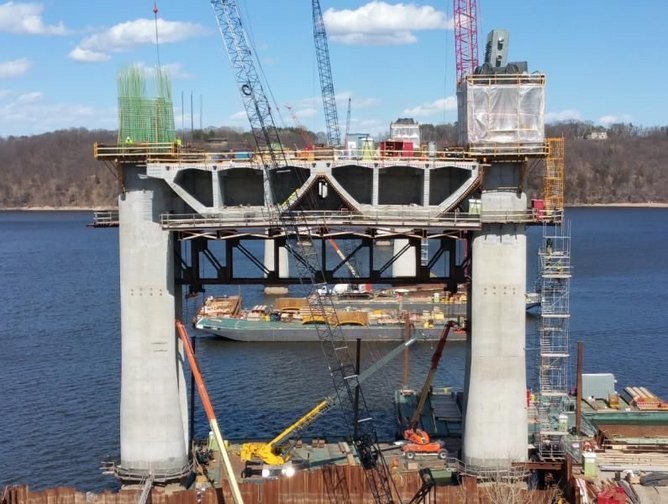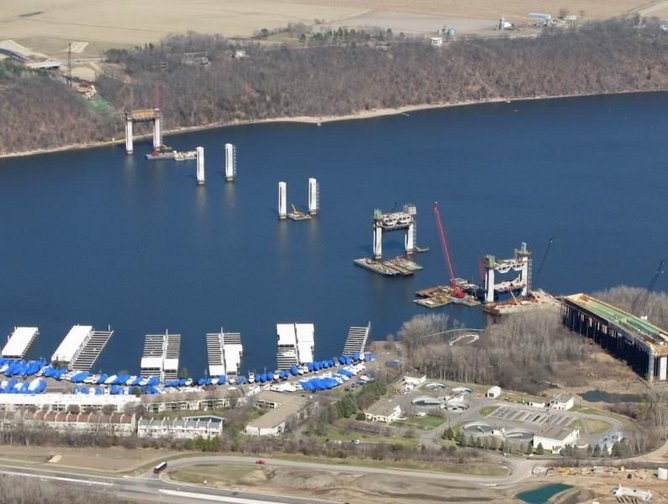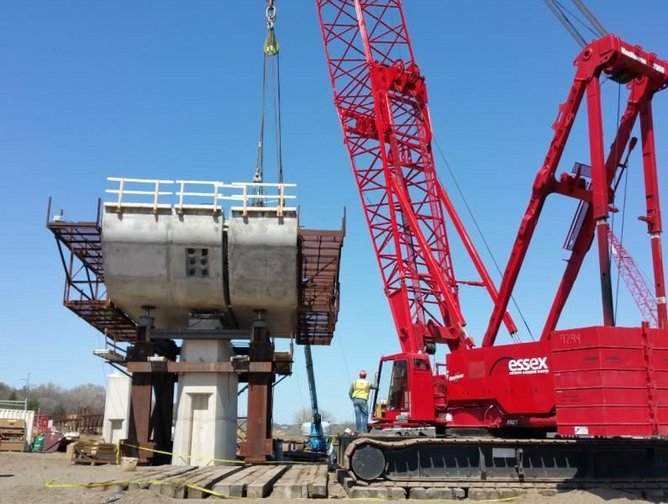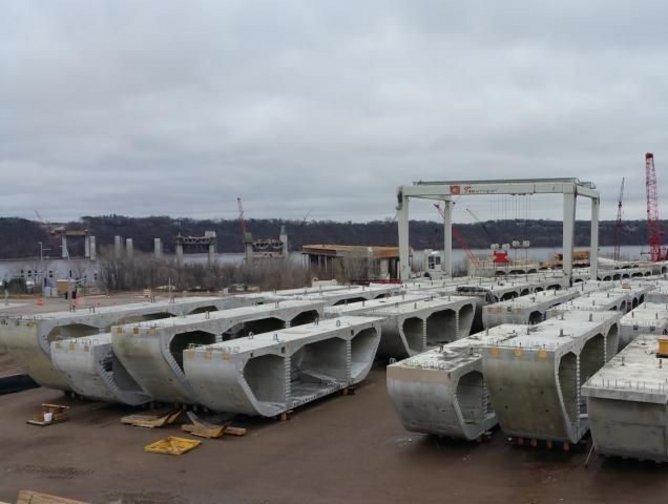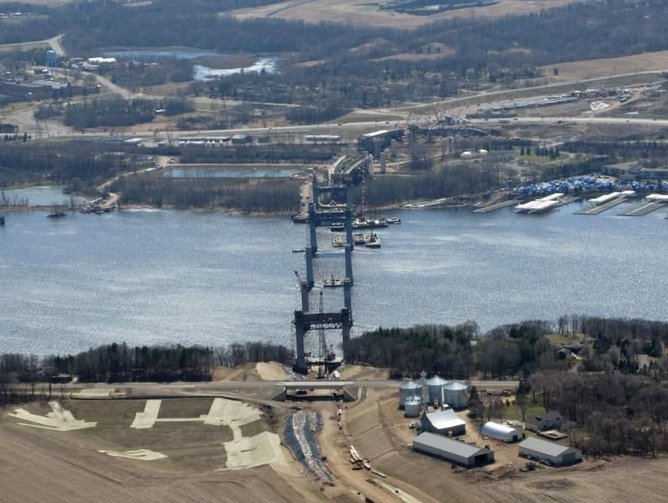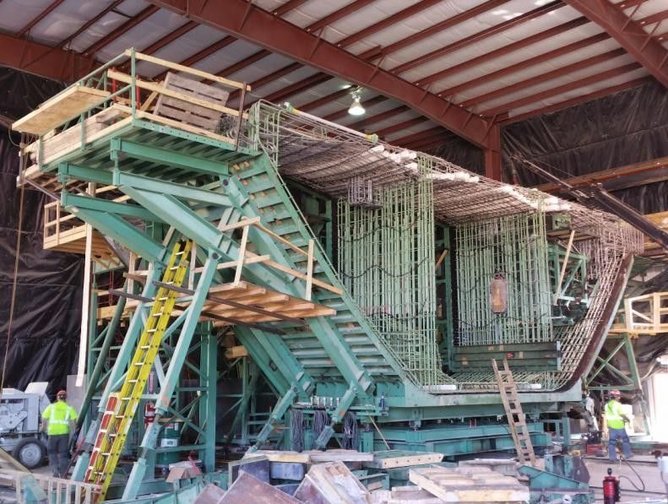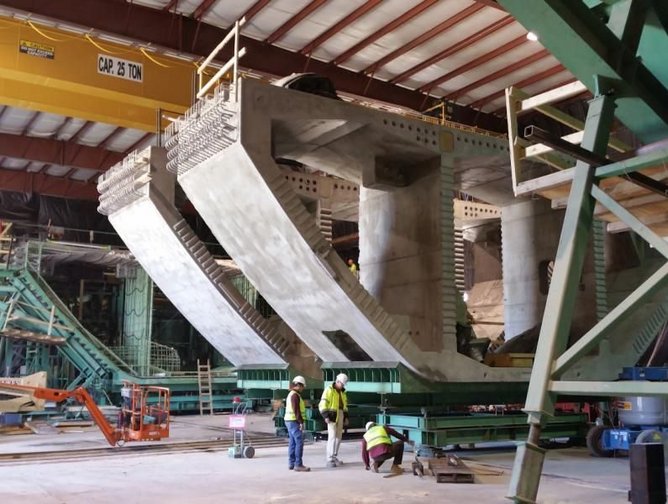St. Croix Crossing Bridge: Connecting Minnesota and Wisconsin
Looking towards Minnesota, U.S.A., the Stillwater Lift Bridge has stood for 80 years—until now. A joint project between the Minnesota Department of Transportation (MnDOT) and the Wisconsin Department of Transportation (WiscDOT) has led to the development of a new extradosed bridge that will replace the Stillwater Lift Bridge with a new four-lane bridge to connect expressways on both sides of the St. Croix River.
Extradosed bridges have been successfully designed and constructed for several years in both Europe and Japan due to their balance of cost, aesthetics, constructability and sensitivity to the environment.
The St. Croix Crossing Bridge has been decades in the making partly because of the many historic, cultural and environmental features along the river.
Expected to have a positive impact on the community, the new bridge will be a signature one in both the state and to the area. Both reducing traffic and offering a number of recreational activities via the addition of loop trails, the St. Croix Crossing Bridge is a project that has been greatly anticipated.
A Project of Magnitude in Size
The St. Croix Crossing Bridge project is running at a total cost of $580 million, with MnDOT’s cost share adding up to $340 million. This cost estimate includes construction, right of way, environmental protection and remediation, contingency, bonds and insurance, engineering and management.
While the project is shared between MnDOT and WisDOT, MnDOT’s focus includes 13 key aspects.
- Reconstruct and realign Hwy 36 and Hwy 95
- Directly connect Hwy 36 and Hwy 95 with ramps and traffic signals
- Add turn lanes at Osgood and Greeley/Oakgreen intersections
- Realign the Hwy 36 intersection at Greeley/Oakgreen
- Realign the North Frontage Road access point north of Osgood intersection
- Create a shared center turn lane on the north and south frontage roads
- Add a trail along the South Frontage Road to connect to the new Loop Trail
- Add ponds to improve storm water runoff and water quality
- Extend the South Frontage Road to Stagecoach Trail
- Reconstruct the Beach Road bridge
- Add traffic signals, lighting, signing and pavement markings
- Implementing new Intelligent Transportation System that includes cameras and traffic detection
- Relocate utilities
With construction commencing back in 2013, the entirety of the project is set to be completed by 2017. The bridge itself, however, will be open to traffic the fall of 2016.
“Once the new bridge is complete and open to traffic, we will also have a 5-mile bike and pedestrian route that will connect the new bridge with the old 1930s Lift Bridge,” said Project Director Michael Beer. “The Lift Bridge is being converted to become part of a 4.7-mile bike and pedestrian trail.”
Constructing the St. Croix Crossing Bridge in 7 Steps
Step 1: Precast Cofferdam Deck System
The pre-fabricated cofferdam deck system is a platform for workers and acts a guide for placing the casings. Eventually, it gets sunk to the river bottom as part of the footing.
Step 2: Spud Piling and Brace Framing
To ensure the cofferdam deck is able to support itself, the workers and the equipment, it is reinforced with additional braces known as spud piles.
Step 3: Install Casings through the Cofferdam Deck System
Multiple 9 ft. diameter hollow casings are placed into the mud and bedrock beneath the river bottom. Casings can range from 90 to 120 ft. long and go through up to 25 ft. of water, 87 ft. of muck, 2 ft. of sand and gravel and 2 ft. of soft stone. Crews then drill about 25 ft. further into the bedrock.
Mud, muck and rock are then drilled out with several different tools. After the muck and mud are removed, crews fill the casing with a rebar cage for support and begin to pour the concrete.
Step 4: Lower Cofferdam
Since the sunken platform where concrete will be poured needs to be dry, a cofferdam is installed to pump water out until the area is dry.
Step 5: Seal Deck System and Build Seal
At this point, crews build a concrete seal to ensure that the structure is stabilized. The concrete seal is between 3 ½ to 4 ft. thick.
Step 6: Construct Footing
On top of the concrete seal from step 5, crews construct a reinforced concrete footing for added strength and stability. A tower is then added to the foundation.
Step 7: Remove Cofferdam
The cofferdam is removed, allowing water to surround the new foundation.
The Bridge to Success
Speaking with Beer, who oversees MnDOT’s construction, surveys and materials program amongst other responsibilities, three key factors were highlighted that have led to the project staying on track and running smoothly.
According to Beer, a Critical Path Method (CPM) schedule, a strong management team and a dedicated workforce have all contributed to the project’s success.
“With a project of this magnitude, having a CPM schedule that keeps everything on track and identifies challenges or opportunities to accelerate the sequence of work is vital,” said Beer.
Primarily hiring locals, the MnDOT staff is also supplemented with consultants simply due to the vast amount of work. While typically consultants would also be from the area, the St. Croix Crossing Bridge project has consultants from Florida that have more expertise in the project’s type of bridge construction.
“[Our team] is invaluable,” emphasized Beer. “With an aggressive schedule, there are problems that come up during the day and night, and needing to keep the project on schedule, it’s critical that we have people out there who can make informed decisions. It’s critical to the success of the project.”
Keeping the Community in Mind
“We’d like to continue to deliver a quality project and do it safely while on time and under budget,” said Beer. “We want to continue to engage the public with our outreach, send out weekly emails with great photos and just keep in constant contact.”
According to Beer, the community has greatly appreciated the level of interaction between the project team and the public. Aside from the communication, boat tours are also being conducted.
“St. Croix is a scenic river and now with this project going on there’s a lot of interest by people to be able to see up-close the construction taking place,” added Beer. “We’ve teamed with the St. Croix Boat and Packet Co. to have project staff on several of their boat tours each month to answer questions and give a narration of what’s going on with the construction of the bridge.”
The St. Croix Crossing Bridge project is a long and arduous one, but once complete it will provide a number of benefits to the community. When all work is finished, motorists will have smoother highway pavement surfaces, improved flow at intersections, an improved frontage road system—including safer access—and a new river crossing between Minnesota and Wisconsin. All of this will occur while maintaining or restoring the area’s cultural, historic and environmental resources.
